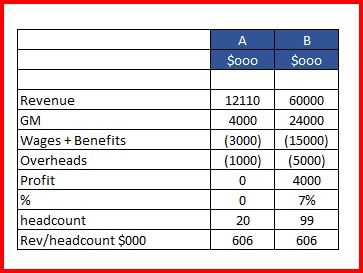It might feel counterintuitive but staying small can be risky. And small is where most US firms are! There are 5.4 million companies out of 6.1 million with 20 employees or less. That’s 89% of US companies. At that size it’s tough to make money. However with the right plan, scaling up to 99 employees could be financially attractive and safer. Let’s look at the math of two manufacturing companies at either end of the spectrum. One has Revenue of just over $12m with 20 employees and the other has Revenue of $60m with 99 employees. The smaller company produces a GM % of 33% and because of economies of scale the larger group produces a GM% of 40%.
We will assume that in both cases average salaries including benefits are approximately $150k per head and that overheads are a third of that total. It’s quite tough to make money as a smaller company but as you scale your volume and keep labor costs and overheads tight, the benefits drop to the bottom line.
Most private companies are in the company A camp and they are lurching from payroll to payroll hoping to keep the doors open. Ironically by putting in place key protocols, policies and new approaches it is possible to break through the Revenue barriers, generate attractive margins and arrive at a safer place.
This can be self-funded if you are patient and smart. It’s all about working on the right stuff. Below we offer some suggestions on how to scale safely.
20 Point Plan
- Simplify the products and services you offer. Focus on one remarkable brand that customers love.
- Build a clear and concise story around the value you bring to a specific audience. Sales is not about selling stuff, it is always about enhancing someone’s life. If you believe you can enhance say the CMO’s life, build a story around how that might work. Align the CMO’s objectives with your product.
- Build a seamless sales experience for customers. Cut out the layers where possible. Allow online sales to be frictionless and in more complex situations ensure access to a knowledgeable sales professional to help make a decision if needed.
- Teach sales professionals about the customer base and the customer’s customer. Product knowledge and clarity around the sales process are assumed but all three are needed to have a meaningful conversation with a prospect.
- Build a diagnostic sales process into your go-to-market strategy. Build insightful questions that uncover the real situation at the customer site.
- Teach the “economic value” concept to demonstrate the power of long term farming of a customer. Don’t go for short term wins but rather long term relationships.
- Dig deep using friends, contacts, sales teams, supplier partners to understand your competitive value proposition. For example a value proposition in say high tech production equipment might state ” Our throughput averages 10,000 units per year with a yield of 95% in a single production shift”. But the question remains, relative to what? You need to compare the ROI on your machine with the competitors relative to throughput and yield.
- Build case studies that prospects relate to. For company x we faced this challenge, and we solved it with this approach generating these results.
- Align your marketing stories around your value proposition to the market. Ask yourself three questions. What is the objective of this campaign (advert, email blast, conference, sponsorship etc), who are we trying reach, and what is the messaging and story we want to tell?
- Build urgency around sales leads. Time kills deals. Demonstrate you care about prospects who reaching out to you.
- No matter how small we all need a plan. It’s never too early to build a simple budget process around objectives for next year. A budget does not start with numbers. It starts with assumptions or policies. Engage your team around what can be achieved, play with various assumptions and build a financial model that shows the implication of those ideas.The final budget will have buy-in, will give you a road map to a stronger business and as you tweak your strategy to accommodate reality, the team will get better at budgeting.
- Related to budgets, is a strong forecasting model. Seeing around corners might not be possible but building a simple forecasting model around all the key economic inputs of the business allows management to instantly see the impact of changed market conditions.
- Simplify your onboarding protocol for new customers. Accelerate the results you promised in the sales process. Give these early customers a reason to remark on you. Let them tell the market you are remarkable.
- Build a mini training curriculum from internal resources. Invite guest speakers for lunch & learns. Teach techs about finance and the accountant about the product. In time transform the early versions into a Company University with courses covering key subjects that will develop your talent. It can be achieved with internal resources and eventually one project manager as you scale.
- Articulate how you do things and turn those thoughts into fun and readable playbooks. Any subject can be turned into a short, well illustrated playbook that be automated. Sales, marketing, finance, talent development, safety, quality, onboarding, recruiting. This demonstrates to outside investors, potential acquirers, potential candidates and internal staff that we know what we are doing around here, and we are happy to share it.
- Attack all meetings with a test. What is the reason to exist for all your existing meetings? Define one to three questions the meeting needs to answer. If the current meeting is not generating answers, kill it. So many meetings will die when faced with this test.
- One meeting that is essential for any size of company is the monthly operational review. Key updates are sent by department/team leads ahead of the meeting. Updates must explain why a performance occurred and where relevant the corrective action to be executed.
- Consider the fractional model, where full time roles can’t be justified. One of the silver linings of an aging population is that there an amazing pool of experienced executives who would like to work one day per week not five. Tap into this huge resource for the cost of a new graduate (I don’t mean a New York based newly minted lawyer)
- Keep communication simple and effective as you scale. Articulate what a future state looks like for you as the CEO and balance ambition with respect to the talent you have in your team but always be recruiting.
- Perhaps the biggest tip for scaling for safety surrounds a simple leadership tip – align effort. A 40 person business aligned around a cause with actions linked to big audacious goals will always outperform a larger business that’s confusing activity with effectiveness.
Ian is the CEO/founder of Boston based The Portfolio Partnership, a Value Creation Practice. We help owners “build businesses buyers love to buy” by deploying our successful playbooks. It starts with Positioning/Branding. We seamlessly join your team to work on the right stuff.
As always if you found these insights useful, please share.









